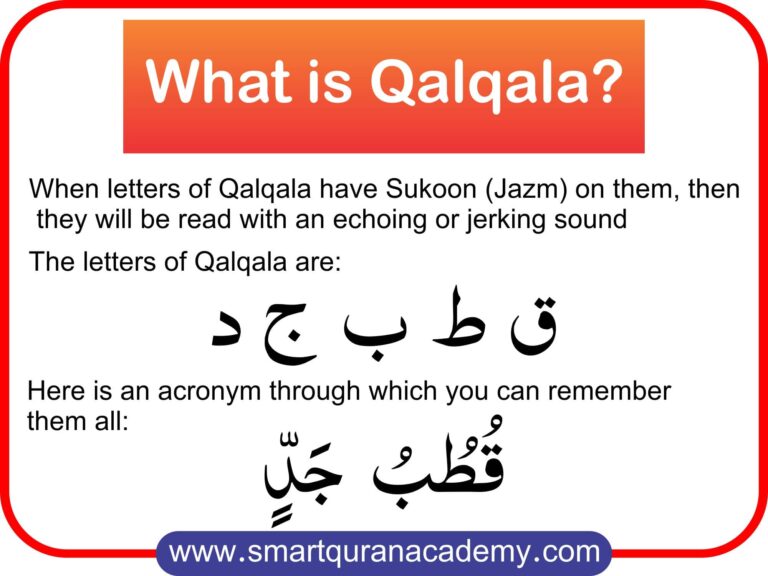Qalqalah Letters In Arabic

The holy Quran is more than just a book that outlines the creation story and the rules Muslims are required to abide by. The Arabic language is likewise guided and preserved by it. Allah communicated His revelations to the Prophet Muhammad in this language. Muslims who read the Quran can gain a stronger understanding of Arabic. They can also understand the text’s subtleties and significance.
The Quran is intended to be read aloud. You need to be familiar with Tajweed in order to execute this correctly. Tajweed describes the right way to pronounce Arabic words. Tajweed directly means “to improve.” You will be able to articulate the language correctly if you master Tajweed’s pronunciation when reading the Quran.
Qalqalah In Tajweed
If any Qalqalah letter shows up with sukoon then it will be read aloud with an echoing sound. It doesn’t matter if it appears at the middle or end of a word. Keep this in mind if you stop on the letter Qalqalah at the end of a word. Strong echoes will be heard as it is spoken. The letter will be pronounced considerably more strongly if it contains a Shaddah.
What Is Qalqalah?
The word itself has a monotonous sound that is just as intriguing as the Tajweed rule. In simple words, it means echo or articulation of sound. In tajweed, it implies to affect the saakin (letter with sukoon) letter.
However, there is no comparable lip or jaw movement that is connected to vowels. Qalqalah “shakes” to “echo” the letter without assuming the diacritic of the letter before or after it.
What Are The 5 Letters of Qalqalah?
There are 5 qalqalah letters in the Arabic language. We are going to mention these qalqalah letters in arabic as follows:
ق ط ب ج د
daal jeem baa tah qaaf
If you want to remember qalqalah letters in quran then no issue! All you need to do is to remember the word that joins all the qalqalah letters, (قطب جد)..
Not just that, Qalqalah is echoing the 5 letters we have mentioned above. Particularly, when they are in the condition of sukoon. For instance:
قْ طْ بْ جْ دْ
Importance Of Qalqalah
Try saying (أط), how about (أق) to get a sense of the significance of Qalqalah. One of two things will happen. Either your tongue becomes stuck in the rear and is difficult to release so you can breathe. Otherwise, your tongue will inevitably slip and your mouth will automatically open again. The foundation of Qalqalah is this “slipping.” You move neither your jaw nor your mouth, disturbing the letter. Try it with the remaining letters, (أد), (أج), and (أب). Try saying the word out loud.
أبْناء
The letter baa (بْ) didn’t “slip,” “shake,” or “echo” at all, did it? Then again, how challenging would it be to utter the noon (ن) with your lips still pursed? Your lips will “slide” little when reciting Qalqalah, or open up slightly without adding a diacritical mark to the baa. It is done to make the noon sound simple to say.
The Levels Of Qalqalah You Need To Know
Now you know what are the 5 letters of qalqalah. At this time, we are going to tell you about three levels of qalqalah. There are different qalqalah letters examples but we are going to mention some from Surat-ul-Masad.
- The Lightest – If a word contains the letter Qalqalah in the middle. For example the ب in the ayat في جيدها حبل من مسد
- The Intermediate – If the letter Qalqalah appears at the end of the word or verse and lacks a shaddah, we stop on it. For example the last ب in the ayat ما أغنى عنه ماله وما كسب
3. The strongest – It is the case when we stop on the Qalqalah letter, which appears at the end of the word or verse and has a shaddah. For example the last ب in the ayat تبت يدا أبي لهب وتب
Why Is Tajweed So Important For Us?
Tajweed is imperative because people who listen to the Quran will be moved by properly pronouncing its language. You must read carefully in order to understand the meaning of the verses, for this reason. It’s essential to understand how to live your life in accordance with the rules and regulations. Tajweed is important because, without it, readers could alter the text’s meaning without realizing it.
You must be aware that Tajweed has two main components: the scientific and the practical if you wish to learn the rules. The science is a part of a communal obligation that calls for at least some Muslims to be familiar with particular Tajweed guidelines. They can therefore impart them to others. Phonetic guidelines for reading and reciting the Quran are part of the practical. As a result, it is effectively communicated and correctly interpreted.
Religious Obligations To Understand
You might be asking what Islam says about tajweed and qalqalah, if it is not compulsory. Tajweed is also recognized as Fard al Kifaya which is a communal obligation. It implies that not all Muslims are required to be aware of these laws. But one individual must be aware of tajweed and qalqalah laws in every town. Every community typically has a Hafiz or a Qari who is familiar with tajweed laws. If so, this fulfills the requirement for religion.
People believe that reading the Quran without following the tajweed guidelines alters the meaning of the verses and is therefore forbidden. Intentionally reciting Quranic verses in a way that alters their meaning is, in fact, sinful. However, when it comes to learning, it is OK if someone makes a mistake that alters the verse’s meaning.
Nevertheless, reading without following the tajweed guidelines does not always mean the meaning will change. If you are familiar with the fundamentals of Quran reading, you can still read it correctly.
In the same way, you have to pay attention to the 5 letters of qalqalah and its three levels. You need to focus on these letters and keep in mind the levels. This will help you articulate the Quran properly. It is our religious obligation to recite the Quran according to its rules and guidelines.If you have any queries or questions smart quran academy online can help you we have qualified teachers.

 +44 7365 472500
+44 7365 472500
